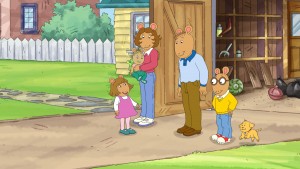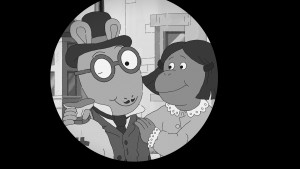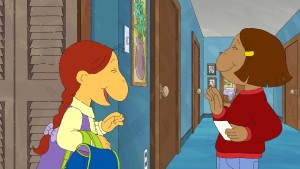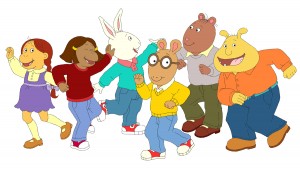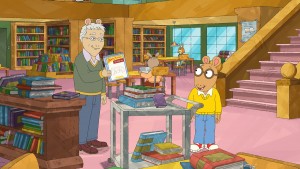ARTHUR, the beloved animated children’s series about eight-year-old aardvark Arthur Timothy Read, is entering its twenty-fifth and final season. The last four episodes air together on PBS on Monday, February 11. These depict what happens to Arthur and his friends when they grow up. Prior to that, all episodes of the previous twenty-four seasons of ARTHUR will air on PBS beginning Wednesday, February 16 (check local listings for times). There’s also THE ARTHUR MOVIE, due out in March from Universal Pictures.
ARTHUR was originally created as an illustrated children’s book by artist and writer Marc Brown. Brown grew up in Erie, Pennsylvania. He serves as an executive producer on the animated ARTHUR, and his Marc Brown Studios is involved in both the book and television series.
Over a Zoom call from New York, Brown talks about the history of his character, and his own history with the books and the series.
ASSIGNMENT X: When you very first started writing and drawing ARTHUR, did you think, “I’d like to do something educational for children,” did you think, “I’d like to draw an aardvark,” did you think, “I’ve drawn this – oh, it looks like an aardvark” …?
MARC BROWN: When I very first started, it was a bedtime story, and I guess the idea at the moment was to entertain. I had just lost a wonderful teaching job, because the college closed, and I realized that I had the opportunity to educate and teach through this bedtime story. And the very first book about Arthur was ARTHUR’S NOSE. He had a problem with his nose. And I had a problem, too – I needed a new job [laughs].
AX: So, why did you decide Arthur should be an aardvark? Was it just the alliteration of “Arthur” and “aardvark”?
BROWN: Well, that came second. The first thing I did was search the pantheon of children’s literature for under-served animals, and “aardvark” was at the head of the line. So, I grabbed the aardvark, and then I looked for an “A” [name] that would go with “aardvark.”
AX: As his surname suggests, Arthur is a big reader. Does he wear glasses to signify that?
BROWN: No. It helps him see better. And the way he holds his glasses on is with Velcro. I had a very astute second-grader ask me that question – “How does Arthur keep those glasses on? Because his ears are [at the top of his head].” So, I had to think fast. In the first book, you’ll notice that he doesn’t have glasses.
A very wonderful librarian, Mary Langford in Dallas, Texas, said to me on one of my very first school visits, “Marc, if you are serious about this, and you want to do this for a living, you are going to need to have a series of books.” And so, I had to think about how I’d build a series. The second book was about his eyes, and that’s when he got his glasses.
AX: When did you start writing and drawing Arthur?
BROWN: Well, the first drawing of Arthur was in 1976, in a bedtime story for my son Tolon, who was about three at the time. He asked me to draw him a picture of what Arthur looked like. So, I did draw a picture of Arthur, and he had a very long, aardvarkian nose. [Tolon] became one of the producers on ARTHUR, and has been for twenty-some years now.
AX: In the ‘90s, when you were approached about making a TV series based on your ARTHUR books, I understand that you were not extremely excited about television as a medium …
BROWN: I had turned down two offers for Saturday morning cartoons, which I was not a big fan of. I have no patience for frenetic cartoons [laughs]. The brilliant Carol Greenwald, from [the Boston station] WGBH, came to me with the concept of using animation and television, two very seductive forces in children’s lives, to do something positive, like make kids want to read. So, that’s where we started with Arthur, with that agenda. And it seemed to have worked. We got incredible feedback from teachers and librarians about kids wanting to check out ARTHUR books. And of course, once we get the kids into the library, they discover that there are all kinds of books there.
AX: What is your involvement with the ARTHUR series? Do you write the scripts, do you comment on the scripts? Do you do any of the artwork that becomes animation?
BROWN: All of the above. I am executive producer for ARTHUR, and before I knew what I was getting myself into, I asked for a lot of approvals in my original contract. The thing I discovered about working in television was how similar it is to working in picture books. I cast my characters, I costume them, I design the sets, I direct them. But with television, all of a sudden, we had the luxury of movement and sound. And also, the luxury of maybe tackling subjects that might not make it into a picture book.
One example comes to mind was the episode where Buster, who has asthma, was trying to explain to his friends what it feels like. With animation, we could have Buster shrink all of his friends, so they went into his nostrils and down into his lungs, and we could show what the inside of Buster’s lungs looked like while he explained what it felt like.
AX: Was it fun to figure out how the different characters would move in animation?
BROWN: Yes. The very first meeting with the animators, they were just pummeling me with questions. “Where is Arthur’s house in relation to Francine’s house?” “What’s Francine’s family like?” “Does Buster have a dad or a mom?” So, the richness of Arthur’s world just grew exponentially with television, which I loved. So, yeah. The question from one of the animators was, “How does Arthur walk?” I thought, “Gee, I don’t know.” I got up, and I started to walk around the table [laughs], and things just kept growing from there.
AX: As far as the voice cast went, does everybody sound like what you originally imagined they would sound like?
BROWN: Well, we got a great Arthur. Michael Yarmush was our first Arthur, and we held onto him as long as we could, until his voice started to change. But the thing that probably most people don’t know is that D.W. [Dora Winifred Read] has been consistently, over the years, voiced by boys. We wanted kind of a gravelly voice, and we weren’t able to get that with any of the girls in the auditions.
AX: You’ve also had some interesting guest stars, like Art Garfunkel as the Moose Singer …
BROWN: The reason we got Art as a guest star was, his son loved the show. That’s often how it happens with some of these guest stars. Or we have wonderful experts that advise us on technically how to craft a story that’s going to be right for our age group and can give enough information and maybe not too much information. One of those wonderful experts is Matt Damon’s mother [early childhood education advocate], Nancy Carlsson-Paige. The poor guy didn’t know what hit him [laughs]. And then I got to turn him into a bear. That’s one of my favorite jobs – turning our guest stars into animals.
AX: What is the dividing line between enough information and too much information?
BROWN: That is so specific to whatever subject we’re tackling. We wanted to do an episode about Alzheimer’s. It’s a disease that’s affected our family, and many families, and it’s just a horrible thing to happen. And for children to have their grandparents suddenly not recognize them, or remember their name – I don’t know where drew the line, but I guess the important message is that Arthur’s grandfather will always love him, and he’s in there somewhere.
So, it’s so specific with each subject we tackle. The beloved Mrs. MacGrady, the cafeteria lady, had a bout with cancer, and that’s another scary thing for kids and families to deal with. I was really proud that we could focus on Francine’s inability to have the strength to offer her love and concern for Mrs. MacGrady’s condition. I think that was a big achievement.
AX: Obviously, when you’re writing and drawing a book, that’s pretty solitary. Does working with other artists and writers for television remind you in any way of coming up with curriculums in academia, or is that a completely different experience to anything you’d had before?
BROWN: When I did agree to move to television, all of a sudden, I had to share Arthur, and I didn’t realize I wasn’t very good at that [laughs]. And as soon as I grasped the concept that I am now part of a team, and I am working with very smart, talented people, and “This is a good thing, Marc, so get on board and have fun,” it just became more fun for me the more I realized where we were headed, and what we could accomplish. Because it is a team, everyone has their special gifts and talents that they bring to ARTHUR. It’s a collective effort on television – it always has been.
AX: Are there things that you can do in the books that you can’t do on television, that you can accomplish with still images and prose that somehow doesn’t translate to animation?
BROWN: Well, I guess because [books are] where I began, the medium is so comfortable for me. One of the things I do in a picture book is, I have the words and the pictures, and it’s this scale that I have to balance. With a picture book, I am always looking for, how can I use less words without sacrificing what I want to say? Because the pictures should do what the words can’t do, or aren’t doing. And the words should be there for things that the pictures can’t necessarily do. So, that’s what’s special for me about a picture book. It’s a medium that I love, especially the illustrations.
I think of myself more as an illustrator than an author. I had to put stories out there to illustrate when I began, because I wasn’t getting good stories to illustrate, and I realized that I had grown up with this incredible gift – I had a great-grandmother, and a Grandma Thora, who told us stories whenever we wanted them. My Grandma Thora, we loved her spooky stories, because she would take out her false teeth to tell them [laughs], and it made them really spooky and fun. So, I guess that’s where I mustered up the confidence to tell a story, or write a story. And I learned a lot about that over the years.
AX: Have you been doing the ARTHUR books throughout the twenty-five years that the series has been on television?
BROWN: Yes. I just finished the last one, BELIEVE IN YOURSELF, which was unique. How many people who write and illustrate picture books have the luxury of writing a book forty-five years later, after you published that first book about a character, and have your audience become parents who grew up with your books, and who are now sharing them with their own children? That was really fun in this book, to be able to write to this dimensional audience. And I guess it’s the closest I’ll come to a memoir. I had a section in there about where Arthur came from, things that he taught us over the years, and writing for picture books, working in television, what that felt like, and be able to thank a lot of people along the way for what they gave to me and Arthur.
AX: By “the last book,” do you mean that’s the final book, or the most recent book?
BROWN: When I started it, I thought maybe it will be the last book, but I probably should never say never, right? I mean, who knows? There may be a subject that feels just right for Arthur. I know I’m really concerned about kids and their safety in schools. And that’s something that I look forward to us tackling.
Even though we are not going to be producing new episodes, we are going to be doing public service spots for kids. We’re going to be doing a podcast, we’re going to be producing new games, things that we didn’t have when we began the series. Technology has changed in twenty-five years, and I think we have to change. So, we’re excited about looking for these new opportunities to reach kids, and perhaps there’s something we can talk about and offer them about school safety. That’s just one of the things that I would like to do.
AX: Who decided ARTHUR should end after twenty-five years? Was that you, or WGBH, or …?
BROWN: It was a collective decision that we made many years ago, actually. We thought, if we’re lucky enough to reach twenty-five, that might be a nice point of closure for making more episodes. Because we have six hundred stories that we’ve done, and specials. Maybe we’ll continue to do specials now and then.
AX: Are you working on anything else right now that we should know about?
BROWN: I am very excited about a project I began about three years for preschoolers, called HOP. It will be an animated series. And for this age group, I’m discovering how much fun I can have with preschoolers. I feel a little bit like I’m on parole [laughs]. But it also is an opportunity to talk to this age group about the power of friendship, about solving problems together, and how kids can do that.
It’s [about] a frog, and he has one leg that’s a little shorter than the other, but it never defines any limitations for him in his life. And he has a little friend, who is an owl with one wing a little shorter than the other, and other friends. Each of them has a little difference in how they are, but they operate without any problems.
AX: Is this animation, or is this a series of books?
BROWN: Yes, it’s an animation. It will be with another network [than WGBH], and we’ll see what happens. But I am very impressed with the group I’m working with, and they are just as careful about scrutinizing what we put into a story and how we deliver it to children. So, that won’t change. The quality of the stories will remain at a pretty high level.
AX: And what would you most like people to know about ARTHUR?
BROWN: He’s an eight-year-old aardvark who is navigating the mud puddles of life. He doesn’t always do it perfectly, but what eight-year-old does?
Follow us on Twitter at ASSIGNMENT X
Fan us on Facebook at ASSIGNMENT X
Article Source: Assignment X
Article: ARTHUR: Creator Marc Brown on the end of his long-lived children’s PBS series – Exclusive Interview
Related Posts:








